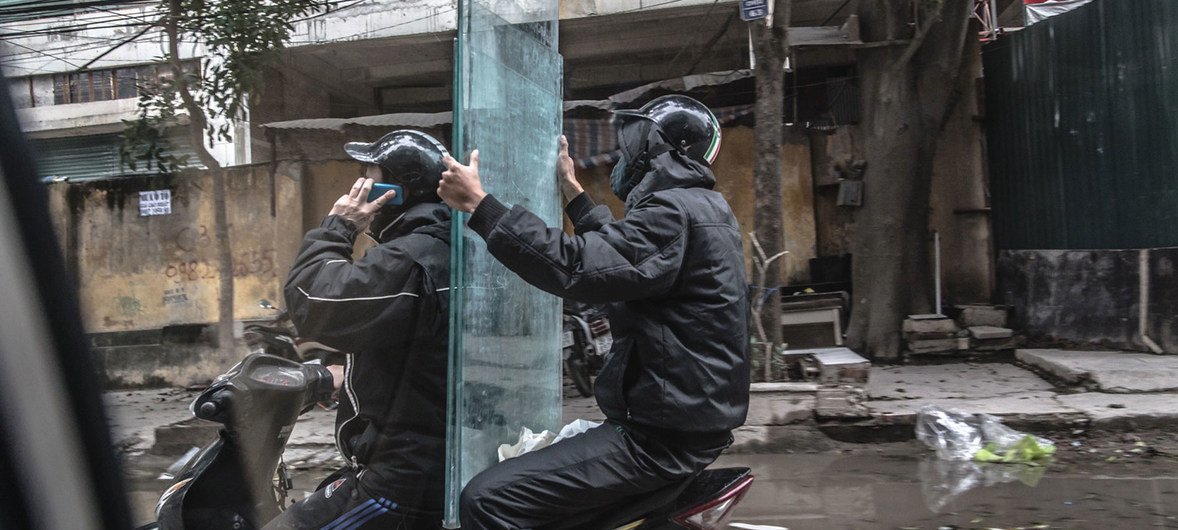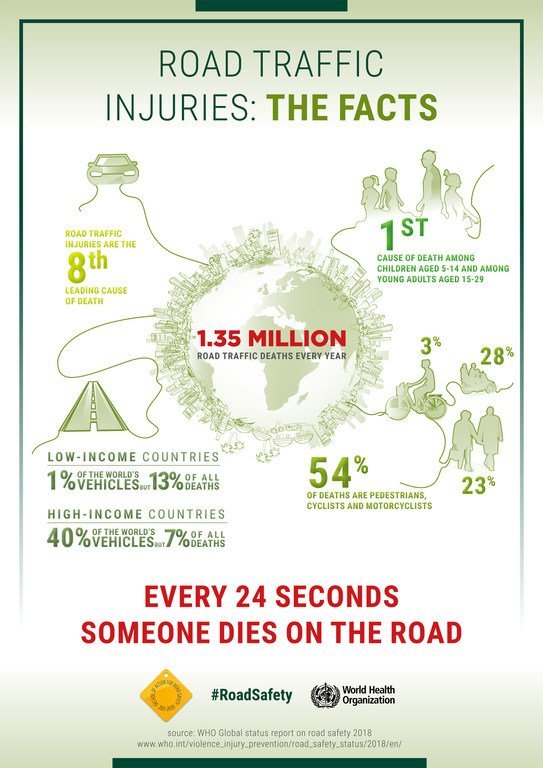Monday, November 18, 2019
JUST IN:Inferno claims acting Permanent Secretary, Pregnant wife and two kids in Makurdi.
Sunday, November 17, 2019
Road Safety Crisis: UN calls for action to tackle ‘ubiquitous but invisible’ global road safety crisis

Saving lives by improving road safety is “one of the many objectives of the 2030 Agenda for Sustainable Development”, the United Nations chief said in his message for the global day set aside for remembering the victims of traffick accidents.
Noting that more than 1.3 million people die in road accidents every year, Secretary-General António Guterres pointed out that more young people between the ages of 15 and 29 die from road crashes annually than from HIV/AIDS, malaria, tuberculosis or homicide.

“The World Day of Remembrance of Road Traffic Victims is an opportunity to reflect on how we can save millions of lives,” he said.
And since 2015, his Special Envoy on Road Safety, Jean Todt, has worked to mobilize political commitment, raise awareness about UN road safety conventions, foster dialogue on good practices and advocate for funding and partnerships.
“While the scale of the challenge is enormous, collective efforts can do much to prevent these tragedies”, the UN chief attested.
In 2018, a UN Road Safety Fund was launched to finance actions in low- and middle-income countries, where around 90 per cent of traffic casualties occur.
And next February, a global ministerial conference on road safety will be held in Sweden to strengthen partnerships to accelerate action.
“Urgent action remains imperative”, concluded the Secretary-General. “On this World Day, I call on all to join forces to address the global road safety crisis.”
‘Ubiquitous yet invisible’
The UN Department of Safety and Security (DSS) calls road traffic crashes a ‘hidden epidemic’.
According to DSS, they have a “dramatically transformative impact” on people’s lives with most causalities remaining “almost invisible to society at large”.
Last February, with the participation of UN leaders from the Secretariat, UN Development Programme (UNDP), UN Population Fund (UNFPA) and others, including the Chef de Cabinet and Special Envoy on Road Safety, the UN launched the Road Safety Strategy in New York and Geneva that showed unity and the shared message of road safety across the UN-system.
The Day has become an important tool in efforts around the world to reduce road casualties.
It offers an opportunity to draw attention to the scale of emotional and economic devastation road crashes cause and recognizes the suffering of victims and the work of rescue services.
Ending fatal road crashes are in line with the 2030 Agenda, particularly in line with Sustainable Development Goal 3 (SDG 3), which encompasses good health and wellbeing and SDG 11 on sustainable cities and communities.
Five pillars of road safety
Pillar 2: Safer vehicles
Pillar 3: Safer road user behaviour
Pillar 4: Post-crash responses
Pillar 5: Safer driving environment
This takes leadership in demonstrating outstanding road safety behavior every day and working together to find the best solutions.
NEWS TRACKER: PAST STORIES ON THIS ISSUE
UN calls for action to tackle ‘ubiquitous but invisible’ global road safety crisis

Saving lives by improving road safety is “one of the many objectives of the 2030 Agenda for Sustainable Development”, the United Nations chief said in his message for the global day set aside for remembering the victims of traffick accidents.
Noting that more than 1.3 million people die in road accidents every year, Secretary-General António Guterres pointed out that more young people between the ages of 15 and 29 die from road crashes annually than from HIV/AIDS, malaria, tuberculosis or homicide.

“The World Day of Remembrance of Road Traffic Victims is an opportunity to reflect on how we can save millions of lives,” he said.
And since 2015, his Special Envoy on Road Safety, Jean Todt, has worked to mobilize political commitment, raise awareness about UN road safety conventions, foster dialogue on good practices and advocate for funding and partnerships.
“While the scale of the challenge is enormous, collective efforts can do much to prevent these tragedies”, the UN chief attested.
In 2018, a UN Road Safety Fund was launched to finance actions in low- and middle-income countries, where around 90 per cent of traffic casualties occur.
And next February, a global ministerial conference on road safety will be held in Sweden to strengthen partnerships to accelerate action.
“Urgent action remains imperative”, concluded the Secretary-General. “On this World Day, I call on all to join forces to address the global road safety crisis.”
‘Ubiquitous yet invisible’
The UN Department of Safety and Security (DSS) calls road traffic crashes a ‘hidden epidemic’.
According to DSS, they have a “dramatically transformative impact” on people’s lives with most causalities remaining “almost invisible to society at large”.
Last February, with the participation of UN leaders from the Secretariat, UN Development Programme (UNDP), UN Population Fund (UNFPA) and others, including the Chef de Cabinet and Special Envoy on Road Safety, the UN launched the Road Safety Strategy in New York and Geneva that showed unity and the shared message of road safety across the UN-system.
The Day has become an important tool in efforts around the world to reduce road casualties.
It offers an opportunity to draw attention to the scale of emotional and economic devastation road crashes cause and recognizes the suffering of victims and the work of rescue services.
Ending fatal road crashes are in line with the 2030 Agenda, particularly in line with Sustainable Development Goal 3 (SDG 3), which encompasses good health and wellbeing and SDG 11 on sustainable cities and communities.
Five pillars of road safety
Pillar 2: Safer vehicles
Pillar 3: Safer road user behaviour
Pillar 4: Post-crash responses
Pillar 5: Safer driving environment
This takes leadership in demonstrating outstanding road safety behavior every day and working together to find the best solutions.
NEWS TRACKER: PAST STORIES ON THIS ISSUE
Saturday, November 16, 2019
International Tolerance Day: UNESCO Chief Says Diversity is a form of wealth, not a factor of division.

At a time when extremism and fanaticism are too often unleashed, when “the venom of hatred” continues to poison a part of humanity, “tolerance has never been more vital a virtue”, the United Nations cultural agency’s chief has said in her message on the International Day for Tolerance.
According to the UN, “Tolerance is more than standing idly by or remaining insensitive to differences between men and women, cultures and beliefs”, Audrey Azoulay, the Director-General of the UN Educational, Scientific and Cultural Organization (UNESCO) said, but instead a “state of mind, an awareness and a requirement.”
Tomorrow is #InternationalDayforTolerance. #Tolerance means respect, acceptance and appreciation of the rich diversity of our cultures and unique ways of being human - @AAzoulay
It is at the core of the @UN values.
In 1996, the UN General Assembly invited Member States to observe the Day each year on 16 November to, among other things, foster mutual understanding among cultures and peoples. The 2019 edition of the Day will be marked this Saturday.
Ms. Azoulay stressed that tolerance is “to realize that cultural diversity is a form of wealth, not a factor of division”.
“It is to perceive that each culture, beyond immediate or apparent differences, is a constituent part of universality and speaks the common language of humanity.”
Quoting former UN Secretary-General Kofi Annan, she said that tolerance is “a virtue that makes peace possible”.
Combatting intolerance
Since its foundation, UNESCO has aimed to “build peace by combating the intolerance that still too often tears our societies apart, and by relentlessly fighting all forms of racism and discrimination”, the agency chief maintained.
Ms. Azoulay cited the words of former Director-General Federico Mayor: “UNESCO bears and echoes the message of tolerance, true to its mission of being ‘the conscience of the United Nations’”.
In conclusion, Ms. Azoulay invited everyone to share UNESCO’s message of tolerance and peace.
Fighting intolerance requires
- Law: Governments are responsible for enforcing human rights laws and banning and punishing hate crimes and discrimination against minorities.
- Education: Greater efforts must be made to teach children about tolerance, human rights and other ways of life, both at home and in school.
- Information access: Policies must be developed to generate and promote press freedom and press pluralism, to allow the public to differentiate between facts and opinions.
- Individual awareness: People should become aware of the link between their behavior and the vicious cycle of mistrust and violence in society, by asking yourself if you stereotype people, reject those who are different from you and/or blame you problems on 'them'?
- Local solutions: Tools of nonviolent action include discrediting hateful propaganda, co-organizing groups to confront problems and establishing grassroot networks to demonstrate solidarity with victims of intolerance.
Abulu Patrick Blog
Development Journalist, Author, Music Promoter, Business Development strategist
SUPPORT US: Email; patrickabuluose@gmail.com
NEWS TRACKER: PAST STORIES ON THIS ISSUE
‘Diversity is a form of wealth, not a factor of division,’ UNESCO chief says ahead of International Day for Tolerance

At a time when extremism and fanaticism are too often unleashed, when “the venom of hatred” continues to poison a part of humanity, “tolerance has never been more vital a virtue”, the United Nations cultural agency’s chief has said in her message on the International Day for Tolerance.
“Tolerance is more than standing idly by or remaining insensitive to differences between men and women, cultures and beliefs”, Audrey Azoulay, the Director-General of the UN Educational, Scientific and Cultural Organization (UNESCO) said, but instead a “state of mind, an awareness and a requirement.”
In 1996, the UN General Assembly invited Member States to observe the Day each year on 16 November to, among other things, foster mutual understanding among cultures and peoples. The 2019 edition of the Day will be marked this Saturday.
Ms. Azoulay stressed that tolerance is “to realize that cultural diversity is a form of wealth, not a factor of division”.
“It is to perceive that each culture, beyond immediate or apparent differences, is a constituent part of universality and speaks the common language of humanity.”
Quoting former UN Secretary-General Kofi Annan, she said that tolerance is “a virtue that makes peace possible”.
Combatting intolerance
Since its foundation, UNESCO has aimed to “build peace by combating the intolerance that still too often tears our societies apart, and by relentlessly fighting all forms of racism and discrimination”, the agency chief maintained.
Ms. Azoulay cited the words of former Director-General Federico Mayor: “UNESCO bears and echoes the message of tolerance, true to its mission of being ‘the conscience of the United Nations’”.
In conclusion, Ms. Azoulay invited everyone to share UNESCO’s message of tolerance and peace.
Fighting intolerance requires
- Law: Governments are responsible for enforcing human rights laws and banning and punishing hate crimes and discrimination against minorities.
- Education: Greater efforts must be made to teach children about tolerance, human rights and other ways of life, both at home and in school.
- Information access: Policies must be developed to generate and promote press freedom and press pluralism, to allow the public to differentiate between facts and opinions.
- Individual awareness: People should become aware of the link between their behavior and the vicious cycle of mistrust and violence in society, by asking yourself if you stereotype people, reject those who are different from you and/or blame you problems on 'them'?
- Local solutions: Tools of nonviolent action include discrediting hateful propaganda, co-organizing groups to confront problems and establishing grassroot networks to demonstrate solidarity with victims of intolerance.









